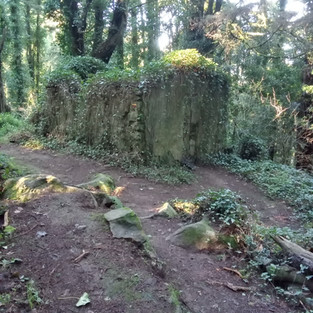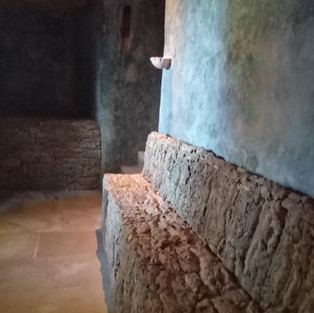Tour in Sintra
- Catarina Araújo

- Mar 3, 2021
- 4 min read
Updated: May 8

In December 2020, while our daughter was visiting her grandparents, we took the opportunity to make a little "getaway" in Sintra. Although our family trips always have the purpose of reconnaissance, for future Quimera programs, this time we just went for a walk and, as we were just by our selves, it was even more relaxed... but with some adventures!
We booked our accommodation at Chalet Relógio, an old historic mansion designed by the architect Luigi Manini, today it has been converted into a Guesthouse overlooking the Sintra Hills and The Moorish Castle.
When we arrived in Sintra, by train, we crossed the historic center, admiring the Christmas lights, the illuminated monuments and the mysterious atmosphere of Sintra. Then we walked up about 700m on the Pena road, at night, until we found the Chalet. It was the winter solstice day, the longest night of the year, and an important astronomical phenomenon was taking place in the sky, the "Star of Bethlehem", in which two great planets - Jupiter and Saturn - were in conjunction. Unfortunately, the sky was too cloudy to see.
Despite being low season, the streets of Sintra were strangely empty, most of the restaurants closed, some Tuk Tuks were still trying to find customers, the buses were empty and the taxi service was provided for the few tourists who went to visit the monuments. In short, tourism waiting for better days after Covid 19.
Tapada de Monserrate and Monk's Trail
The next day we went for a walk through Tapada de Monserrate to Convent of the Capuchos and then made the connection with the PR1 SNT - Monk's Trail.
The Scotturb bus 435, which runs the circuit Train Station - Regaleira - Monserrate - Colares - Train Station, was empty and left us next to the Monserrate Palace, where we started our walk, in the picnic area. We found several ponds, which supply the waterfalls of the Palace of Monserrate Park. This ponds are a habitat for several species, having recently been the target of an intervention to control invasive species. The forest, in the heart of the Sintra-Cascais Natural Park, used to be the shelter for some emblematic species of fauna such as the roe deer, the wolf and the bear, which were hunted here in the recent past. Today we can only find the sculptures of these large mammals.
Arriving at Convent of the Capuchos, we start the Monk's Trail with an ascent to the Memorial of Soldiers monument, where 25 soldiers lost their lives in the fight against the great fire of 1966.
On this way, we pass through areas populated by exotic invaders, such as the incense tree, which are the main ecological problem of the park. Fortunately, we also pass through areas of great beauty and magic, such as the cedar forests of Buçaco.
Then we climb to the 3rd highest point of the entire Sintra Mountain, with 491m high, where there is a geodesic vertex and the Tholos of the Monk. Tholos of the Monk is an ancient mass grave, built in the Chalcolithic period. Inside the circular-shaped ruin formed by stones, several remains were found that confirm the importance of this construction.
We continue our walk until we reach a point where you can see the ocean. There we returned again to the Convent of the Capuchos, which we went to visit.
Convent of the Capuchos
This convent, belonging to the Franciscan Order, contrasts with other exuberant monuments in Sintra, for its simplicity and lack of luxury. We were impressed by the small size of the dormitory cells. But this poverty of construction is compensated for by the mysticism of the surrounding nature, which merges with the construction itself. The primitive forest has been kept intact until today.
We recommend a visit to this Convent to explore its corners, such as the Terreiro das Cruzes, the Cloister or the Chapel of the Crucifixion.
So far we had followed a route on our GPS that, on the way back, passed through Quinta das Sequóias and Quintinha de Monserrate. However, the GPS decided to malfunction and we had to try to find the same path that we had followed at the beginning. What was left to explore is for a next visit! Our stay was short this time, but we will be back.
Some curiosities about Sintra Mountain
Sintra Mountain is rich in water mines, which, when descending the slopes of the mountain, will be collected by Ribeira de Colares.
The Mountain is formed by an eruptive massif with an abundance of granites, syenites, gabbros and diorites.
The weather is characterized by lower temperatures and higher precipitation than in the surrounding regions, due to the proximity of the ocean, the relief and the dense vegetation.
The agriculture, the search for firewood, the exploitation of wood and shipbuilding contributed to a profound deforestation of the mountains in the mid-18th century. From the 19th century onwards, the repopulation of forests and the transformation of agricultural properties on the northern slopes, into leisure forests and romantic parks - as a result of the fascination with flora from all over the world - created an exquisite landscape.






















Comments